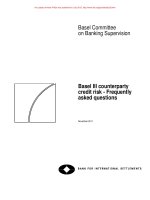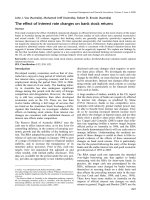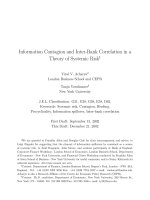Handbook of basel III capital enhancing bank capital in practice
Bạn đang xem bản rút gọn của tài liệu. Xem và tải ngay bản đầy đủ của tài liệu tại đây (28.2 MB, 751 trang )
Table of Contents
Cover
Title Page
Copyright
Dedication
Preface
About the Author
Chapter 1: Overview of Basel III
1.1 Introduction to Basel III
1.2 Expected and Unexpected Credit Losses and Bank Capital
1.3 The Three-Pillar Approach to Bank Capital
1.4 Risk-Weighted Assets (RWAs)
Chapter 2: Minimum Capital Requirements
2.1 Components and Minimum Requirements of Bank Capital
2.2 Components and Minimum Requirements of Capital Buffers
2.3 Capital Conservation Buffer
2.4 Countercyclical Buffer
2.5 Systemic Risk Buffers
2.6 Going Concern vs. Gone Concern Capital
2.7 Case Study: UBS vs. JP Morgan Chase G-SIB Strategies
2.8 Transitional Provisions
Chapter 3: Common Equity 1 (CET1) Capital
3.1 CET1 Minimum Requirements
3.2 Eligibility Requirements of CET1 Instruments
3.3 Case Study: UBS Dividend Policy and its Impact on CET1
3.4 Case Study: Santander Dividend Policy and its Impact in CET1
3.5 Accumulated Other Comprehensive Income
3.6 Case Study: Banco BPI’s Partial Disposal of Portfolio of Portuguese and Italian
Government Bonds
3.7 Other Items Eligible for CET1 Capital
3.8 CET1 Prudential Filters
3.9 Additional Valuation Adjustments
3.10 Intangible Assets (Including Goodwill)
3.11 Case Study: Danske Bank’s Goodwill Impairment
3.12 Case Study: Barclays Badwill Resulting from its Acquisition of Lehman
Brothers N.A.
3.13 Deferred Tax Assets
3.14 Fair Value Reserves Related to Gains or Losses on Cash Flow Hedges
3.15 Negative Amounts Resulting from the Calculation of Expected Loss Amounts
3.16 Equity Increases Resulting from Securitised Assets
3.17 Gains or Losses on Liabilities Valued at Fair Value Resulting from Changes in
Own Credit Standing
3.18 Defined-Benefit Pension Plans
3.19 Case Study: Lloyds’ De-Risking of its Defined Benefit Pension Plans
3.20 Holdings by a Bank of Own CET1 Instruments
3.21 Case Study: Danske Bank’s Share Buyback Programme
3.22 Case Study: Deutsche Bank’s Treasury Shares Strategy
3.23 Holdings of the CET1 Instruments of Financial Sector Entities
3.24 Deduction Election of 1,250% RW Assets
3.25 Amount Exceeding the 17.65% Threshold
3.26 Foreseeable Tax Charges Relating to CET1 Items
3.27 Excess of Qualifying AT1 Deductions
3.28 Temporary Filter on Unrealised Gains and Losses on Available-for-Sale
Instruments
Chapter 4: Additional Tier 1 (AT1) Capital
4.1 AT1 Minimum Capital Requirements
4.2 Criteria Governing Instruments Inclusion in AT1 Capital
4.3 Deductions from AT1 Capital
4.4 Holdings of AT1 Instruments of Other Financial Institutions
4.5 Case Study: Lloyds Banking Group Exchange Offer of Tier 2 for AT1 Securities
Chapter 5: Tier 2 Capital
5.1 Tier 2 Capital Calculation and Requirements for Inclusion
5.2 Negative Amounts Resulting from the Calculation of Expected Loss Amounts
5.3 Deductions from Tier 2 Capital
5.4 Holdings of Tier 2 Instruments of Other Financial Institutions
5.5 Case Study: Deutsche Bank’s Tier 2 Issue
Chapter 6: Contingent Convertibles (CoCos)
6.1 Types of CoCos
6.2 Trigger Levels
6.3 CoCos’ Statutory Conversion or Write-Down — Point of Non-Viability
6.4 CoCo’s Coupon Suspension — Maximum Distributable Amount
6.5 Adding Pillar 2 Capital Requirements to the MDA Calculation
6.6 Case Study: Barclays’ Equity Convertible CoCo
6.7 Case Study: Deutsche Bank’s Write-Down CoCo
6.8 CoCos from an Investor’s Perspective
Chapter 7: Additional Valuation Adjustments (AVAs)
7.1 Fair Valuation Accounting Framework (IFRS 13)
7.2 Case Study: Goldman Sachs Investment in Industrial and Commercial Bank of
China
7.3 Prudent Valuation vs. Fair Valuation
7.4 Additional Valuation Adjustments (AVAs) Under the Core Approach
7.5 Market Price Uncertainty AVA
7.6 Close-Out Costs AVA
7.7 Model Risk AVA
7.8 Unearned Credit Spreads AVA
7.9 Investing and Funding Costs AVA
7.10 Concentrated Positions AVA
7.11 Future Administrative Costs AVA
7.12 Early Terminations Costs AVA
7.13 Operational Risk AVA
Chapter 8: Accounting vs. Regulatory Consolidation
8.1 Accounting Recognition of Investments in Non-Structured Entities
8.2 Accounting for Full Consolidation
8.3 Working Example on Consolidation
8.4 Loss of Control
8.5 The Equity Method — Associates
8.6 Case Study: Deutsche Bank’s Acquisition of Postbank
8.7 IFRS Consolidation vs. Regulatory Consolidation
Chapter 9: Treatment of Minority Interests in Consolidated Regulatory Capital
9.1 Minority Interests Included in Consolidated CET1
9.2 Minority Interests Included in Consolidated AT1, Tier 1, Tier 2 and Qualifying
Total Capital
9.3 Illustrative Example 1: Calculation of the Impact of Minority Interests on
Consolidated Capital
9.4 Illustrative Example 2: Calculation of the Impact of Minority Interests on
Consolidated Capital
9.5 Case Study: Artificial Creation of Minority Interests
9.6 Case Study: Banco Santander Repurchase of Minority Interests in Santander
Brasil
Chapter 10: Investments in Capital Instruments of Financial Institutions
10.1 Basel III Treatment of Investments in Capital Instruments of Financial
Institutions
10.2 Worked Examples of Investments in Capital Instruments of Unconsolidated
Financial Institutions
10.3 Case Study: BBVA’s Acquisition of Garanti
Chapter 11: Investments in Capital Instruments of Insurance Entities
11.1 The Concept of Double Leverage
11.2 Case Study: ING’s Double Leverage
11.3 Regulatory Peculiarities of Investments in Insurance Entities
11.4 Case Study: Lloyds Banking Group’s Capital Enhancement Initiatives Related
to its Insurance Subsidiaries
Chapter 12: Equity Investments in Non‐financial Entities
12.1 Basel III and Equity Exposures to Non-Financial Entities in the Banking Book
12.2 Equity Exposures Under the Standardised Approach
12.3 Equity Exposures Under the IRB Approach
12.4 Expected Losses from Equity Exposures Under the IRB Approach
12.5 Qualified Holdings Outside the Financial Sector Exceeding the 15% Threshold
12.6 Temporary Exemption from the IRB Treatment of Certain Equity Exposures
12.7 Case Study: CaixaBank’s Mandatory Exchangeable on Repsol
12.8 Case Study: Mitsubishi UFJ Financial Group’s Corporate Stakes
Chapter 13: Deferred Tax Assets (DTAs)
13.1 Taxes from an Accounting Perspective
13.2 Accounting for Deferred Taxes Arising from Temporary Differences —
Application to Equity Investments at Either FVTPL or FVTOCI
13.3 Worked Example: Temporary Differences Stemming from Debt Instruments
Recognised at Fair Value
13.4 Case Study: UBS’s Deferred Tax Assets
13.5 Deferred Tax Assets from a Regulatory Capital Perspective
13.6 Case Study: Spanish Banks Conversion of DTAs Into Tax Credits, Improving
Their CET1 Positions
13.7 Case Study: Lloyds Banking Group’s Expected Utilisation of Deferred Tax
Assets
13.8 Initiatives to Reduce Impacts of Deferred Tax Assets on Bank Capital
Chapter 14: Asset Protection Schemes and Bad Banks
14.1 ING’s Illiquid Asset Back-Up Facility with the Dutch State
14.2 Royal Bank of Scotland’s Asset Protection Scheme
14.3 Case Study: SAREB, The Spanish Bad Bank
14.4 Case Study: NAMA, The Irish Bad Bank
14.5 Asset Protection Schemes versus Bad Banks
Chapter 15: Approaching Capital Enhancement Initiatives
15.1 Initial Thoughts
15.2 Overview of Main CET1 Capital Ratio Enhancement Initiatives
15.3 Case Study: Deutsche Bank’s Rights Issue
15.4 Case Study: Structuring the Disposal of a Portfolio of NPLs
15.5 Case Study: Banco Popular Joint Venture with Verde Partners and Kennedy
Wilson
15.6 Case Study: Co-Operative Bank’s Liability Management Exercise
Glossary
Bibliography
Index
End User License Agreement
List of Tables
Chapter 2: Minimum Capital Requirements
Table 2.1 UBS's G‐SIB Indicators and their Amounts
Table 2.2 UBS's Score of G‐SIB Indicators
Table 2.3 UBS's Calculation of Final G‐SIB Score
Table 2.4 Implications of a separation between JP Morgan's retail activities and its
corporate and investment bank
Table 2.5 Phase‐in Eligibility AT1 and Tier 2 Instruments
Table 2.6 Transitional Provisions Regarding Capital Conservation and G‐SIB
Buffers
Chapter 3: Common Equity 1 (CET1) Capital
Table 3.1 HSBC's Fully‐loaded CET1 Capital as of 31 December 2015
Table 3.2 Santander's Outstanding Number of Ordinary Shares under the Previous
and New Dividend Policies (in millions)
Table 3.3 Translation of Subco's Assets, Liabilities and Shareholders' Equity on
Acquisition Date
Table 3.4 Translation of Subco's Shareholders' Equity on Acquisition Date
Table 3.5 ParentCo's, SubCo's and the Group's Balance Sheets as of 1 January 20X0
Table 3.6 SubCo's Stand‐alone Balance Sheet as of 31 December 20X0
Table 3.7 Translation of SubCo's Statement of Financial Position on 31 December
20X0
Table 3.8 Exchange Differences Stemming from the Translation of SubCo's Balance
Sheet
Table 3.9 Fixed‐rate Bond Main Terms
Table 3.10 Calculation of Interest Income and Amortised Cost Amounts
Table 3.11 Period Change in Bond's Clean Fair Value
Table 3.12 Amounts recognised in the FVOCI Reserve
Table 3.13 BPI's Bond Portfolio and Related Hedges Unrealised Losses as of 31
December 2013
Table 3.14 BPI's Bond Portfolio and related Hedges Unrealised Losses as of 31
March 2014
Table 3.15 Main Terms of Bank ABC's Floating‐rate Bond
Table 3.16 Main Terms of Bank ABC's Interest Rate Swap
Table 3.17 Bond Interest and Swap Settlement Amounts
Table 3.18 Swap Effective and Ineffective Amounts
Table 3.19 Initiatives taken by Lloyds to reduce its OCI Volatility due to its DBPPs
Table 3.20 Main Terms of Deutsche Bank's Forward on its own Shares
Table 3.21 Calculation of Interest Expense and Carrying Amount of the Liability
Table 3.22 Main Terms of Deutsche Bank's Put Option on Own Shares
Table 3.23 Calculation of Interest Expense and the Liability Carrying Amount
Table 3.24 Main Terms of Deutsche Bank's Call Option on Own Shares
Chapter 4: Additional Tier 1 (AT1) Capital
Table 4.1 Main Terms of Lloyds' USD ECN Bond
Table 4.2 Main Terms of Lloyds' GBP AT1 Instruments
Chapter 5: Tier 2 Capital
Table 5.1 Template of Tier 2 Instruments' Main Terms
Table 5.2 Main Terms of Deutsche Bank's USD Tier 2 Issue
Table 5.3 Calculation of Interest Expense and Amortised Cost Amounts
Chapter 6: Contingent Convertibles (CoCos)
Table 6.1 Comparative Main Terms of AT1 CoCos and Tier 2 Instruments
Table 6.2 Main terms of Barclays Bank's GBP AT1
Table 6.3 Main terms of Deutsche Bank's EUR tranche contingent convertible
Chapter 7: Additional Valuation Adjustments (AVAs)
Table 7.1 Calculation of unreduced valuation exposure
Table 7.2 Calculation of reduced valuation exposure
Chapter 8: Accounting vs. Regulatory Consolidation
Table 8.1 Aggregation of Megabank's and Trustbank's financial statement items
Table 8.2 Elimination entries performed to the combined financial statements
Table 8.3 Non‐controlling interest adjustment
Table 8.4 Consequent consolidation worksheet
Table 8.5 Consolidated profit or loss statement
Table 8.6 Fair valuation of Postbank's identifiable assets and liabilities
Chapter 9: Treatment of Minority Interests in Consolidated Regulatory Capital
Table 9.1 Capital position of Bank S
Table 9.2 Calculation of the qualifying consolidated capital attributable to minority
interests
Table 9.3 Calculation of consolidated regulatory capital
Chapter 10: Investments in Capital Instruments of Financial Institutions
Table 10.1 Fair valuation of Garanti's identifiable assets and liabilities
Chapter 12: Equity Investments in Non‐financial Entities
Table 12.1 Main terms of CaixaBank's mandatory exchangeable into Repsol
Chapter 13: Deferred Tax Assets (DTAs)
Table 13.1 Carrying amount for assets and liabilities
Table 13.2 Main terms of the debt instrument acquired by Megabank
Table 13.3 Calculation of each period interest income and amortised cost amounts
Table 13.4 Calculation of the period change in the debt's fair value
Table 13.5 Calculation of amounts in OCI related to the debt investment
Table 13.6 Calculation of the debt's tax base related to its amortised cost balances
Table 13.7 Calculation of the debt's tax base related to its interest income
Table 13.8 Temporary differences arising from the debt investment where taxation
is based on its amortised cost
Table 13.9 Temporary differences arising from the debt investment where taxation
is based on its original cost
Table 13.10 Calculation of reversing temporary differences requiring further
assessment of utilisation
Table 13.11 Calculation of the adjusted taxable profit (or loss) for utilisation
assessment
Table 13.12 Expiries of UBS's unrecognised tax loss carry forwards
Table 13.13 Main sources of Lloyds' gross deferred tax assets
Table 13.14 Main sources of Lloyds' gross deferred tax liabilities
Table 13.15 Sale and leaseback transactions undertaken by Santander
Table 13.16 Main terms of Santander's sale and leaseback transaction on its
headquarters building complex
Chapter 14: Asset Protection Schemes and Bad Banks
Table 14.1 Asset types covered by RBS's asset protection scheme
Table 14.2 Scenarios of potential conversion of RBS's B shares
Table 14.3 Actions on RBS's share capital in 2008 and 2009
Table 14.4 Geographical split of NAMA's collateral
Chapter 15: Approaching Capital Enhancement Initiatives
Table 15.1 Quorum and voting requirements to obtain approval by the holders of
the exchanged instruments
List of Illustrations
Chapter 1: Overview of Basel III
Figure 1.1 Bank regulatory capital accords
Figure 1.2 Expected and unexpected credit losses
Figure 1.3 The three pillars around Basel III
Figure 1.4 Pillar 1 of Basel III
Figure 1.5 Liquidity coverage
Figure 1.6 Main components of RWAs
Chapter 2: Minimum Capital Requirements
Figure 2.1 Components of a bank's regulatory total capital
Figure 2.2 Minimum CET1 requirements including capital buffers
Figure 2.3 Interaction of the countercyclical buffer with the capital conservation
buffer
Figure 2.4 Interaction of the countercyclical buffer with the credit‐to‐GDP gap
Figure 2.5 Countercyclical buffer situation
Figure 2.6 Systemic risk buffers
Figure 2.7 Group/subsidiary – G‐SII/O–SII/SRB combinations
Figure 2.8 Going concern vs. gone concern regulatory capital
Figure 2.9 G‐SIIs – Individual indicators of designation criteria
Figure 2.10 RWAs divisional breakdown, as at the end of 2014
Figure 2.11 EUR/USD spot rate (Jan‐13 to Apr‐15)
Figure 2.12 Three‐dimensional assessment of G‐SIB enhancement initiatives
Figure 2.13 G‐SIB surcharge share of each Corporate and Investment Banking
division business (2014)
Figure 2.14 G‐SIB indicator distribution within the Corporate and Investment
Banking division (2014)
Chapter 3: Common Equity 1 (CET1) Capital
Figure 3.1 Components in the calculation of CET1
Figure 3.2 Main elements of (accounting) shareholders' equity
Figure 3.3 Balance sheet effects of the scrip dividend
Figure 3.4 Balance sheet effects of the cash dividend
Figure 3.5 EBA's hierarchy in the calculation of a dividend payout ratio
Figure 3.6 UBS dividends and buybacks 2000–2014
Figure 3.7 UBS's 2011–2014 CET1 capital ratio
Figure 3.8 Accounting impact of UBS's stock dividend paid using treasury shares
Figure 3.9 Impact on CET1 of UBS's stock dividend paid using treasury shares
Figure 3.10 Accounting impact of UBS's stock dividend paid with newly issued
shares
Figure 3.11 Impact on CET1 of UBS's stock dividend paid with newly issued shares
Figure 3.12 Impact on UBS's balance sheet and CET1 capital of a CHF 2,961 mn
cash dividend
Figure 3.13 Santander scrip dividend – alternatives to shareholders
Figure 3.14 Santander scrip dividend: cash vs. shares election by shareholders
Figure 3.15 Santander's outstanding number of ordinary shares
Figure 3.16 Accounting shareholders' equity section
Figure 3.17 Net assets of a foreign operation
Figure 3.18 Elements of the net assets of a foreign subsidiary
Figure 3.19 Group's structure post‐acquisition
Figure 3.20 Process to calculate exchange differences
Figure 3.21 IFRS 9 financial assets classification categories – summary flowchart
Figure 3.22 Second‐year impact on the bank's balance sheet of the debt investment
at FVTOCI
Figure 3.23 BPI's asset swap of Italian and Portuguese bond portfolio
Figure 3.24 Balance sheet recognition of BPI's asset swap of Italian and Portuguese
bond portfolio
Figure 3.25 Balance sheet recognition of BPI's asset swap of Italian and Portuguese
bond portfolio
Figure 3.26 Impact of BPI's bond investment strategy on CET1 ratio as of 31
December 2013
Figure 3.27 Goodwill amounts using the partial and full goodwill methods
Figure 3.28 Badwill resulting from Barclays' acquisition of Lehman Brothers NA
Figure 3.29 Recognition of the change in fair value of a hedging instrument
Figure 3.30 Accounting for a cash flow hedge
Figure 3.31 Overall annual interest expense
Figure 3.32 Effects in profit or loss in absence of hedge accounting application
Figure 3.33 Hedge accounting terminology: hedged item and hedging instrument
Figure 3.34 Effects of the hedge on Bank ABC's financial statements on 31‐Dec‐
20X1
Figure 3.35 Treatment of the shortfall in provisions from expected losses
calculated under the IRB approach
Figure 3.36 Treatment of the excess in provisions from expected losses calculated
under the IRB approach
Figure 3.37 IFRS 9 financial liabilities classification categories
Figure 3.38 CVA/DVA calculation steps
Figure 3.39 CVA/DVA calculation first step
Figure 3.40 CVA/DVA calculation second step
Figure 3.41 CVA/DVA calculation third step – first task
Figure 3.42 CVA/DVA calculation third step – second task
Figure 3.43 CVA/DVA calculation third step – third task
Figure 3.44 CVA/DVA calculation third step – final task
Figure 3.45 My own pecking order regarding PD calculation sources
Figure 3.46 Example of CVA/DVA allocation using a relative fair value approach
Figure 3.47 Defined benefit pension plans balance sheet recognition
Figure 3.48 Changes in the assets of a defined benefit pension plan
Figure 3.49 Items of a defined benefit pension plan recognised in profit or loss, or
OCI
Figure 3.50 Initiatives taken by Lloyds on its defined benefit pension plans
Figure 3.51 Impact of its buyback programme on Danske Bank's statement of
financial position
Figure 3.52 Initial recognition of Deutsche Bank's forward on own shares
Figure 3.53 Recognition of Deutsche Bank's forward on own shares during the first
year
Figure 3.54 Impact on CET1 of Deutsche Bank's forward on own shares, following
its settlement
Figure 3.55 Scenarios at maturity of Deutsche Bank's sale of put option on own
shares
Figure 3.56 Initial recognition of Deutsche Bank's sale of put on own shares
Figure 3.57 Recognition of Deutsche Bank's sale of put on own shares on 31
December 20X0
Figure 3.58 Overall impact of Deutsche Bank's sale of put on own shares – option
exercised
Figure 3.59 Overall impact of Deutsche Bank's sale of put on own shares – option
not exercised
Figure 3.60 Scenarios at maturity of Deutsche Bank's purchase of call option on
own shares
Figure 3.61 Initial recognition of Deutsche Bank's purchase of call on own shares
Figure 3.62 Overall impact of Deutsche Bank's purchase of call on own shares –
option exercised
Figure 3.63 Overall impact of Deutsche Bank's purchase of call on own shares –
option not exercised
Figure 3.64 Deutsche Bank's share price during 2014
Figure 3.65 Amounts exceeding the 17.65% threshold
Figure 3.66 Excess of qualifying AT1 deductions
Chapter 4: Additional Tier 1 (AT1) Capital
Figure 4.1 Tier 1 minimum capital requirements
Figure 4.2 Calculation of a bank's AT1 capital
Figure 4.3 Excess of qualifying Tier 2 deductions
Figure 4.4 Treatment of investments in AT1 instruments of other financial
institutions
Figure 4.5 Main terms of Lloyds' B shares
Figure 4.6 Basel II regulatory capital categories
Figure 4.7 APS regulatory capital effects
Figure 4.8 APS strengths and weaknesses
Figure 4.9 Share of losses in Lloyds' APS
Figure 4.10 APS – Benefits vs. cost profile excluding the 7% dividend
Figure 4.11 Accounting impact of exchange offer
Figure 4.12 Lloyds' Core Tier 1 and CET1 capital as of 31 December 2013
Figure 4.13 Impact of exchange in Lloyds' regulatory capital
Figure 4.14 Accounting impact of Lloyds' exchange offer
Chapter 5: Tier 2 Capital
Figure 5.1 Tier 2 capital in a bank's regulatory total capital
Figure 5.2 Components of a bank's Tier 2 capital
Figure 5.3 Treatment of the excess in provisions from expected losses calculated
under the IRB approach
Figure 5.4 Treatment of investments in Tier 2 instruments of other financial
institutions
Figure 5.5 Effects of the Tier 2 instrument on Deutsche Bank's financials at the
end of the first year
Chapter 6: Contingent Convertibles (CoCos)
Figure 6.1 CoCos classification according to their loss absorption mechanism
Figure 6.2 Stages in a bank financial situation
Figure 6.3 BRRD – Priority of instruments subject to (and excluded from) bail‐in
Figure 6.4 Composition of the combined buffer requirement
Figure 6.5 Bounds of each MDA quartile as a function of excess CET1
Figure 6.6 MDA factor
Figure 6.7 MDA factor including Pillar 1 and Pillar 2 capital requirements
Figure 6.8 Barclays' capital levels prior and following the CoCo issuance
Figure 6.9 Barclays' 7.875% CoCo – Headroom to contractual trigger at issuance
Figure 6.10 Barclays' 7.875% CoCo – Headroom to coupon payment restrictions
Figure 6.11 Convertible CoCo – Suggested split to assess accounting recognition
Figure 6.12 Initial recognition of Barclays' convertible CoCo
Figure 6.13 Barclays' convertible CoCo – Balance sheet impact of a coupon
payment
Figure 6.14 Recognition of Barclays' convertible CoCo upon conversion
Figure 6.15 EUR‐denominated CoCo – Call rights and coupon reset dates
Figure 6.16 AT1 issuance effects on Deutsche Bank's Tier 1 capital
Figure 6.17 Deutsche Bank AT1 – Headroom to trigger
Figure 6.18 Deutsche Bank – CET1 plus combined buffer requirement
Figure 6.19 Ranking of Deutsche Bank's CoCo
Figure 6.20 Write‐down CoCo – Suggested split to assess accounting recognition
Figure 6.21 Deutsche Bank's write‐down CoCo – Initial recognition
Figure 6.22 Deutsche Bank's write‐down CoCo – Initial impact on balance sheet
Figure 6.23 Deutsche Bank's write‐down CoCo – Recognition of a coupon payment
Figure 6.24 Deutsche Bank's write‐down CoCo – Recognition of a write‐down
Figure 6.25 Deutsche Bank's write‐down CoCo – Recognition of a write‐up
Figure 6.26 Deutsche Bank's write‐down CoCo – Bifurcation on initial recognition
Figure 6.27 Deutsche Bank's write‐down CoCo – Initial impact on balance sheet
Figure 6.28 Deutsche Bank's write‐down CoCo – Subsequent recognition
Figure 6.29 Deutsche Bank's write‐down CoCo – Balance sheet impact of the write‐
down
Figure 6.30 Deutsche Bank's write‐down CoCo – Balance sheet impact of the write‐
up
Chapter 7: Additional Valuation Adjustments (AVAs)
Figure 7.1 Additional valuation adjustments: fair value vs. prudent value
Figure 7.2 Commonly fair valued financial items in a bank's balance sheet
Figure 7.3 IFRS 13's framework
Figure 7.4 IFRS 13's fair value definition
Figure 7.5 Market for fair value pricing
Figure 7.6 Three‐Level Fair Value Hierarchy
Figure 7.7 Decision tree for the Level classification of financial instruments (part
one)
Figure 7.8 Decision tree for the Level classification of financial instruments (part
two)
Figure 7.9 Fair valuation on the basis of net position: decision tree
Figure 7.10 Derivative hedge process
Figure 7.11 Derivative initial profit recognition
Figure 7.12 Accounting vs. regulatory valuations
Figure 7.13 Prudent valuation framework
Figure 7.14 Confidence interval and AVAs
Figure 7.15 EBA's prudent valuation approaches
Figure 7.16 Fair value hedge accounting
Figure 7.17 AVA categories under the EBA's core approach
Figure 7.18 IPV function – Interaction with other valuation areas in a bank
Figure 7.19 Reliability hierarchy of market data sources
Figure 7.20 Steps in the calculation of the market price uncertainty AVA
Figure 7.21 Megabank portfolios subject to prudent valuation
Figure 7.22 Megabank – Vector of parameters used to risk manage the EUR
interest rate swap book
Figure 7.23 Megabank – Vector of parameters identified as lacking or having
market price uncertainty
Figure 7.24 Megabank – EUR swap book exposures (amounts in EUR thousands)
Figure 7.25 Megabank – EUR swap book exposures reduced to seven parameters
Figure 7.26 Steps in the calculation of the prudent mid‐price
Figure 7.27 Upper and lower boundaries with a 90% confidence interval in a
normal distribution – Small sample size
Figure 7.28 Upper and lower boundaries with a 90% confidence interval in a
normal distribution – Large sample size
Figure 7.29 Allocation to other AVAs of unearned credit spreads AVA
Figure 7.30 Allocation to other AVAs of investing and funding costs AVA
Figure 7.31 Calculation of concentrated positions AVAs – Flowchart
Figure 7.32 Basel III approaches to operational risk
Figure 7.33 Approaches to operational risk AVA
Chapter 8: Accounting vs. Regulatory Consolidation
Figure 8.1 Accounting recognition of equity investments
Figure 8.2 Representation of a non‐controlling interest in a group's financial
statements
Figure 8.3 Simplified calculation of a non‐controlling interest
Figure 8.4 Main intercompany items in banking
Figure 8.5 Structure of the Megabank group
Figure 8.6 Book vs. fair values of Trustbank's net assets
Figure 8.7 Megabank's balance sheet after acquisition
Figure 8.8 Megabank's consolidated balance sheet
Figure 8.9 Megabank's balance sheet after loss of control over Banktrust
Figure 8.10 Ownership structure of Postbank were the initial acquisition to
materialise (it did not happen)
Figure 8.11 Main clauses of the initial agreement between Deutsche Bank (DB) and
Deutsche Post (DP)
Figure 8.12 Ownership structure of Postbank after its capital increase
Figure 8.13 Main elements of the restructured agreement between Deutsche Bank
and Deutsche Post
Figure 8.14 Ownership structure of Postbank assuming full implementation of the
restructured agreement
Figure 8.15 Impact on Deutsche Bank's balance sheet of its initial investment in
Postbank
Figure 8.16 Impact on Deutsche Bank's balance sheet related to the Postbank
transaction
Figure 8.17 Regulatory treatment of Deutsche Bank's initial equity investment in
Postbank
Figure 8.18 Impact on CET1 of Deutsche Bank's initial equity investment in
Postbank
Chapter 9: Treatment of Minority Interests in Consolidated Regulatory Capital
Figure 9.1 Structure of the Bank P group
Figure 9.2 Bank P and Bank S, stand‐alone and consolidated balance sheets
Figure 9.3 Bank S's Tier 1 capital and its contribution to consolidated Tier 1 capital
Figure 9.4 Trustbank's minimum capital requirements
Figure 9.5 Creating non‐deductible minority interests
Figure 9.6 SmallBank's consolidated balance sheet, ignoring the derivative fair
valuing
Figure 9.7 Banco Santander (Brasil) – Shareholding prior and after the IPO
Figure 9.8 Initial recognition of the mandatorily convertible bond into Banco
Santander (Brasil) shares
Figure 9.9 Impact on CET1 capital of the transfer of the Banco Santander (Brasil)
shares by Banco Santander S.A
Figure 9.10 Planned timetable of Santander Brasil minority buyout at the time of
its announcement
Figure 9.11 Effect on the group's CET1 capital of Santander Brasil minority buyout
Chapter 10: Investments in Capital Instruments of Financial Institutions
Figure 10.1 Main regulatory approaches on investments in capital instruments of
financial institutions
Figure 10.2 General framework of the regulatory treatment of investments in
capital instruments of banks
Figure 10.3 General framework of the regulatory treatment of investments in
capital instruments of insurance companies
Figure 10.4 Basel III's treatment of non‐significant investments in the capital
instruments of unconsolidated financial institutions
Figure 10.5 Basel III treatment of risk‐weighted capital investments in the banking
book
Figure 10.6 Relevant CET1 for 10% threshold
Figure 10.7 Basel III's treatment of significant investments in capital instruments
of unconsolidated financial entities
Figure 10.8 Relevant CET1 capital for 10% threshold calculations
Figure 10.9 Garanti's ownership structure following BBVA's initial investment
Figure 10.10 Regulatory capital effects of BBVA's equity investment in Garanti
Figure 10.11 Fictional regulatory treatment of BBVA's equity investment in Garanti
Figure 10.12 Capital impact of fictional regulatory treatment of BBVA's equity
investment in Garanti
Figure 10.13 Accounting and regulatory impact of BBVA's stake increase in Garanti
Figure 10.14 Two‐step acquisition
Figure 10.15 Effect on BBVA's CET1 of its investment in Garanti after assuming
control
Chapter 11: Investments in Capital Instruments of Insurance Entities
Figure 11.1 Individual and consolidated balance sheets – double leverage
Figure 11.2 Customer financial life cycle
Figure 11.3 ING's strategic priorities following its agreement with the EU
Figure 11.4 Steps in the separation of ING's banking and insurance/asset
management businesses
Figure 11.5 ING Group's new structure
Figure 11.6 ING's deadlines for the divestments of its insurance businesses
Figure 11.7 Alternatives to dispose of ING's insurance businesses
Figure 11.8 ING Group's capital position as of 31 December 2011
Figure 11.9 Regulatory treatment of investments in capital instruments of
insurance entities
Figure 11.10 Main subsidiaries of Lloyds Banking Group
Figure 11.11 Basel III's treatment of significant investments in unconsolidated
financial entities
Figure 11.12 Accounting and regulatory effects of dividend from Lloyds' insurance
subsidiaries
Figure 11.13 Accounting and regulatory effects on Lloyds of the disposal of St
James's Place
Chapter 12: Equity Investments in Non‐financial Entities
Figure 12.1 Risk weights of equity exposures held in the banking book under the
standardised approach
Figure 12.2 Methods available under the IRB approach for equity exposures in the
banking book
Figure 12.3 Thinking behind Basel III's credit risk approach
Figure 12.4 Number of shares to be received in the case of physical settlement
Figure 12.5 Value of the instrument at maturity, ignoring dividends, as a function
of Repsol's share price
Figure 12.6 CaixaBank's stake in Repsol – equity method recognition
Figure 12.7 Initial recognition of the mandatory exchangeable
Figure 12.8 Impact of the mandatory exchangeable on CaixaBank's balance sheet
Figure 12.9 Impact on CET1 of CaixaBank's stake in Repsol
Figure 12.10 Nikkei 225 index spot price (1‐Jan‐13 to 31‐Mar‐15)
Figure 12.11 MFUG's price‐to‐book value (1‐Jan‐13 to 31‐Mar‐15)
Figure 12.12 MFUG's acquisition cost of its domestic equity holdings
Figure 12.13 Calculations of MUFG's CET1 capital of the potential disposal of its
equity holdings
Figure 12.14 Impact on MUFG's CET1 capital of the potential disposal of its equity
holdings
Chapter 13: Deferred Tax Assets (DTAs)
Figure 13.1 Recognition of taxes in the balance sheet and profit or loss statements
Figure 13.2 Income taxes overview
Figure 13.3 Current income tax recognition
Figure 13.4 Steps for accounting for deferred taxes
Figure 13.5 Deductible deferred assets: DTA vs. valuation allowance
Figure 13.6 Steps in the assessment of the utilisation of deductible temporary
differences
Figure 13.7 Steps in the assessment of the utilisation of deductible temporary
differences
Figure 13.8 Tax base determination – Debt instruments
Figure 13.9 Steps in the assessment of the utilisation of deductible temporary
differences
Figure 13.10 Resulting utilisation of deductible temporary differences through the
two‐step process
Figure 13.11 UBS's reported DTAs and DTLs, as of 31 December 2014
Figure 13.12 Items in UBS's deductible deferred taxes, as of 31 December 2014
Figure 13.13 Items in UBS's taxable deferred taxes, as of 31 December 2014
Figure 13.14 Location of UBS's tax loss carry forwards (pre‐tax amounts), as of 31
December 2014
Figure 13.15 Recognition of UBS's tax loss carry forwards, as of 31 December 2014
Figure 13.16 Deferred tax items recognised in UBS's shareholders' equity, as of 31
December 2014
Figure 13.17 Basel III (CRR) treatment of tax assets
Figure 13.18 Regulatory treatment of DTAs that rely on future profitability and
arise from temporary differences
Figure 13.19 Relevant CET1 for DTAs' 10% threshold calculations
Figure 13.20 Relevant CET1 for 17.65% threshold calculations
Figure 13.21 Spanish banks' DTAs as a percentage of Basel II's core capital, end of
2013
Figure 13.22 Spanish Royal Decree and [CRR 39] requirements
Figure 13.23 Impact of the changes in DTA laws on Banco Santander, as of year‐
end 2014
Figure 13.24 Disclosed DTAs and DTLs in Lloyds' consolidated balance sheet, as of
year‐end 2014
Figure 13.25 Structure of Lloyds' deductible deferred tax assets, as of year‐end 2014
Figure 13.26 Structure of Lloyds' taxable deferred tax assets, as of year‐end 2014
Figure 13.27 Reconciliation of Lloyds' accounting vs. regulatory DTAs, as of year‐
end 2014
Figure 13.28 Calculation of regulatory impact of Lloyds' DTAs, as of year‐end 2014
(part I of II)
Figure 13.29 Calculation of regulatory impact of Lloyds' DTAs, as of year‐end 2014
(part II of II)
Figure 13.30 Impact on CET1 capital ratio of Lloyds' DTAs, as of year‐end 2014
(part II of II)
Figure 13.31 Sources of utilisation of deductible temporary differences
Figure 13.32 Sources of utilisation of deductible tax loss and tax credit
carryforwards
Figure 13.33 Types of initiative to enhance impact of deferred taxes on regulatory
capital
Figure 13.34 Recovery of an asset: ordinary income/expense vs. capital gain/loss
Figure 13.35 HSBC USA funding vs. dividends distributions
Figure 13.36 Sale and leaseback of Santander's headquarters
Chapter 14: Asset Protection Schemes and Bad Banks
Figure 14.1 Transfer pricing of 80% of ING's Alt‐A portfolio
Figure 14.2 Recognition of 80% of ING's Alt‐A portfolio
Figure 14.3 Main flows of ING's IABF during its life
Figure 14.4 ING's balance sheet before and after the IABF
Figure 14.5 ING's IABF – summary of potential benefits (excluding capital
securities and rights issues)
Figure 14.6 UK government's aid to RBS during the 2008–09 credit crisis
Figure 14.7 RBS's APS – Share of losses
Figure 14.8 RBS's APS – Share of losses split between expected and unexpected
losses
Figure 14.9 RBS's APS – Summary of potential benefits
Figure 14.10 SAREB's balance sheet structure at inception
Figure 14.11 NAMA's balance sheet structure at 31 December 2010
Chapter 15: Approaching Capital Enhancement Initiatives
Figure 15.1 Common pattern of the business cycle in banking
Figure 15.2 Main initiatives to enhance CET1 capital ratios
Figure 15.3 Deutsche Bank's rights issue timeline of key events
Figure 15.4 Conflicting interests between the bank and the investor
Figure 15.5 General structure of a disposal of a portfolio of NPLs
Figure 15.6 Accounting roadmap for the assessment of control of an entity
Figure 15.7 Assets to be included in the derecognition assessment
Figure 15.8 Accounting roadmap of a financial asset derecognition assessment
Figure 15.9 End result of a financial asset derecognition assessment
Figure 15.10 Example of tax efficient group structure
Figure 15.11 Significant risk transfer
Figure 15.12 Aliseda SGI ownership structure
Figure 15.13 Aliseda initial transaction structure
Figure 15.14 Aliseda's balance sheet as of 31 December 2013
Figure 15.15 Impact on Banco Popular's balance sheet of its investment in Aliseda
Figure 15.16 Impact on Banco Popular's CET1 ratio of its investment in Aliseda
Figure 15.17 Impact on Banco Popular's capital of its equity exposure in Aliseda
Figure 15.18 Types of LME transactions
Figure 15.19 Co‐operative Bank's ownership structure
Figure 15.20 Main terms of Co‐operative Bank's liability management exercise
Figure 15.21 CET1 effects of Co‐operative Bank's liability management exercise and
capital contribution
Handbook of Basel III Capital
Enhancing Bank Capital in Practice
JUAN RAMIREZ
This edition first published 2017
© 2017 Juan Ramirez
Registered office
John Wiley & Sons Ltd, The Atrium, Southern Gate, Chichester, West Sussex, PO19 8SQ,
United Kingdom
For details of our global editorial offices, for customer services and for information about
how to apply for permission to reuse the copyright material in this book please see our
website at www.wiley.com.
All rights reserved. No part of this publication may be reproduced, stored in a retrieval
system, or transmitted, in any form or by any means, electronic, mechanical,
photocopying, recording or otherwise, except as permitted by the UK Copyright, Designs
and Patents Act 1988, without the prior permission of the publisher.
Wiley publishes in a variety of print and electronic formats and by print-on-demand.
Some material included with standard print versions of this book may not be included in
e-books or in print-on-demand. If this book refers to media such as a CD or DVD that is
not included in the version you purchased, you may download this material at
. For more information about Wiley products, visit
www.wiley.com.
Designations used by companies to distinguish their products are often claimed as
trademarks. All brand names and product names used in this book are trade names,
service marks, trademarks or registered trademarks of their respective owners. The
publisher is not associated with any product or vendor mentioned in this book.
Limit of Liability/Disclaimer of Warranty: While the publisher and author have used
their best efforts in preparing this book, they make no representations or warranties with
respect to the accuracy or completeness of the contents of this book and specifically
disclaim any implied warranties of merchantability or fitness for a particular purpose. It
is sold on the understanding that the publisher is not engaged in rendering professional
services and neither the publisher nor the author shall be liable for damages arising
herefrom. If professional advice or other expert assistance is required, the services of a
competent professional should be sought.
Library of Congress Cataloging-in-Publication Data is available
ISBN 9781119330820 (hardcover) ISBN 9781119330806 (ePDF)
ISBN 9781119330899 (ePub)
Cover Design: Wiley
Cover Image: © Vasiliy Yakobchuk/iStockphoto
To my wife Marta and our children Borja, Martuca and David









